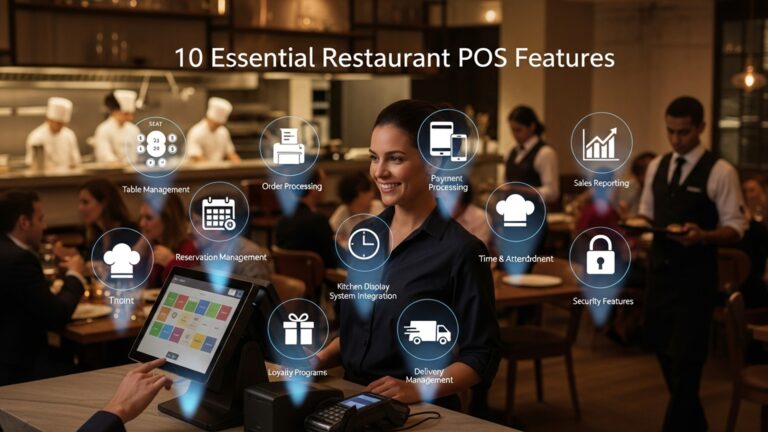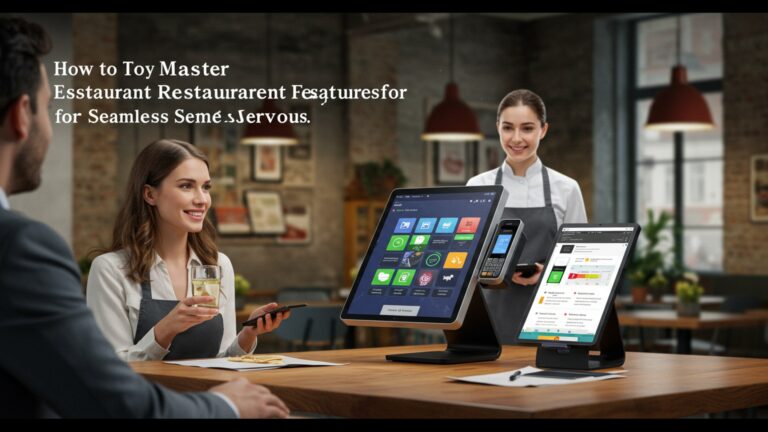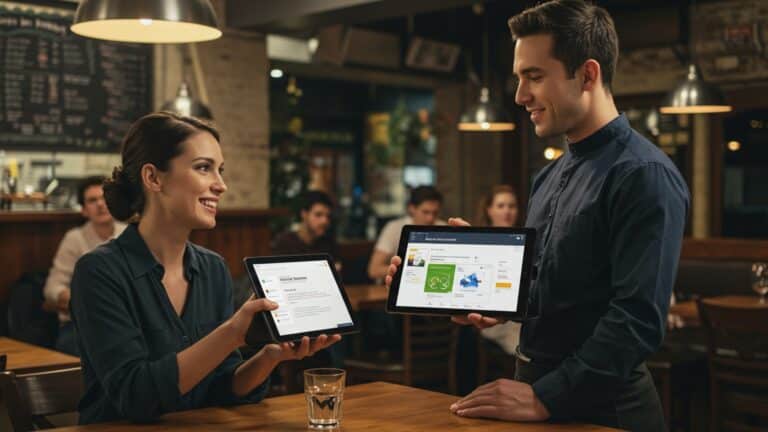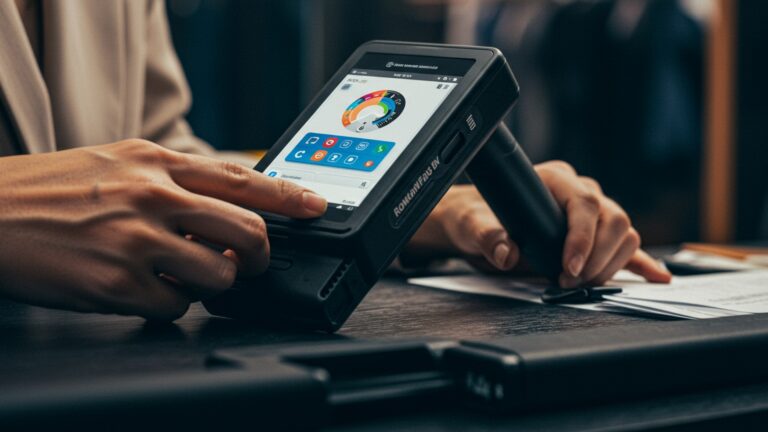How to Pick the Best Restaurant POS System 7 Smart Steps
Choosing the optimal Restaurant POS software defines a venue’s operational backbone and future profitability, extending far beyond simple transaction processing. In today’s competitive hospitality sector, a superior system integrates critical functions like online ordering, contactless payments via QR codes. real-time inventory management, moving beyond outdated cash register functionalities. The best platforms now offer AI-driven data analytics, providing insights into peak demand or menu performance, rather than just basic sales reports. This strategic investment in modern POS technology, embracing cloud-native solutions and seamless third-party integrations, prevents common operational bottlenecks and significantly enhances both staff productivity and guest experience. Smart selection ensures long-term scalability and adaptability in a rapidly evolving digital marketplace.

Step 1: Assess Your Restaurant’s Unique Operational Needs
Before diving into the myriad of features offered by various Restaurant POS software, the most critical first step is to conduct a thorough self-assessment of your establishment. Every restaurant, whether a bustling fine-dining experience, a quick-service cafe, a food truck, or a multi-location chain, has distinct operational workflows and requirements. A POS system isn’t a one-size-fits-all solution; what works perfectly for a pizzeria might be overkill or insufficient for a gourmet bistro.
Consider the following aspects to build a clear profile of your needs:
- Restaurant Type
- Full-Service Restaurants (FSR)
- Quick-Service Restaurants (QSR)
- Bars & Nightclubs
- Cafes & Bakeries
- Food Trucks
- Size and Scale
- Current Challenges
- Budget
Require robust table management, split checks, order routing to different kitchen stations. server performance tracking.
Need fast order entry, integrated drive-thru management, combo meal customization. efficient queue management.
Focus on quick tab management, robust inventory for liquor, age verification. potentially integrated pour control systems.
Emphasize modifiers for drinks (e. g. , extra shot, almond milk), customer loyalty programs. perhaps pre-order capabilities.
Prioritize mobile capabilities, offline mode functionality. compact hardware solutions.
How many terminals do you need? Do you have multiple locations that require centralized management and reporting? Future growth plans should also be factored in. A system that scales easily can save significant migration costs down the line.
What pain points are you trying to solve with a new Restaurant POS software? Is it slow order processing, inaccurate inventory, difficulty managing staff, or lack of customer data? Identifying these will help you prioritize features.
Establish a realistic budget not just for the initial purchase but also for ongoing subscriptions, hardware, training. support. We’ll delve deeper into pricing models later.
For instance, a small, independent coffee shop might prioritize ease of use, a strong loyalty program. affordable monthly fees, potentially opting for an iPad-based system. Conversely, a high-volume steakhouse would likely require advanced reservation management, detailed inventory tracking for expensive cuts of meat. seamless integration with kitchen display systems (KDS).
Step 2: grasp Core Restaurant POS Software Features
Once you’ve clearly defined your needs, it’s time to interpret the essential features that modern Restaurant POS software offers. A Point of Sale (POS) system is the central nervous system of your restaurant, handling everything from taking orders to processing payments and managing back-of-house operations. Understanding these features will help you differentiate between systems and match them to your Step 1 assessment.
- Order Management
- Intuitive Interface
- Customizable Menus
- Table Management
- Order Routing
- Split Checks & Payments
- Payment Processing
- Integrated Card Processing
- Gift Card & Loyalty Programs
- Offline Mode
- Inventory Management
- Real-time Tracking
- Recipe Management
- Vendor Management
- Reporting & Analytics
- Sales Reports
- Cost of Goods Sold (COGS)
- Labor Reports
- Customer Data
- Employee Management
- Time Clock
- Shift Scheduling
- Permissions & Roles
Easy for staff to learn and navigate, reducing training time and errors.
Ability to add, edit. remove menu items, modifiers (e. g. , “no onions,” “extra cheese”). special pricing.
For FSRs, visual floor plans, table status tracking (seated, ordered, paid). easy table transfers or merges.
Automatically send specific items to the correct kitchen or bar station, improving efficiency and accuracy.
Essential for groups, allowing customers to pay separately by item or amount.
Seamlessly accept credit/debit cards, contactless payments (NFC). mobile payments (Apple Pay, Google Pay). This reduces manual errors and speeds up transactions.
Built-in functionality to manage gift cards and reward loyal customers with points or discounts.
Crucial for food trucks or areas with unreliable internet, allowing transactions to be processed and synced later.
Monitor ingredient levels, receive alerts for low stock. manage vendor orders. This helps reduce waste and prevent stockouts.
Track ingredient usage per dish to accurately cost items and manage inventory depletion.
Streamline purchasing and supplier relationships.
Daily, weekly, monthly sales data, top-selling items, peak hours. server performance.
comprehend profitability per menu item.
Track employee hours, sales per employee. payroll data.
Insights into customer preferences, visit frequency. spending habits to tailor marketing efforts.
Track employee clock-ins and outs, breaks. overtime.
Create and manage staff schedules, often with communication tools.
Define access levels for different staff members (e. g. , servers, managers, owners).
A modern Restaurant POS software should also offer cloud-based capabilities. Unlike traditional on-premise systems that store data locally, cloud-based POS systems store data on remote servers, accessible via the internet. This offers flexibility, automatic updates. data security. For example, a restaurant owner can monitor sales and inventory from home on their laptop or phone, a capability impossible with older, server-bound systems.
Step 3: Evaluate Hardware Compatibility & Reliability
While the software is the brain, the hardware is the body of your Restaurant POS system. The best Restaurant POS software is only as good as the hardware it runs on. Reliability, durability. ease of use are paramount in a fast-paced restaurant environment. Consider the following hardware components:
- POS Terminals
- Touchscreen Monitors
- Tablets (iPad, Android)
- Integrated Terminals
- Printers
- Receipt Printers
- Kitchen Printers/Bar Printers
- Cash Drawers
- Payment Terminals/Card Readers
- Kitchen Display Systems (KDS)
- Barcode Scanners
These are the main screens where orders are taken and payments are processed.
Standard for most modern systems, ensuring quick and intuitive operation.
Popular for their portability, lower cost. sleek design, especially in cafes or food trucks. They allow servers to take orders tableside, reducing errors and speeding up service.
All-in-one units that combine the screen, processor. sometimes a printer or card reader.
For customer receipts.
To send orders to the relevant prep stations. Ensure they are robust and designed for kitchen environments (e. g. , splash-proof).
Secure storage for cash transactions, typically triggered by the POS system upon cash payment.
EMV (chip card) compliant readers are essential for security. Look for devices that support NFC (contactless) payments as well.
Digital screens in the kitchen that display orders, helping chefs manage tickets, track prep times. ensure accuracy, especially crucial in high-volume kitchens.
Useful for retail components in cafes or bakeries, or for tracking inventory received.
When selecting hardware, consider the environment. A ruggedized tablet might be perfect for a food truck exposed to elements, while a sleek, fixed terminal suits a high-end restaurant. Ensure the hardware is compatible with your chosen Restaurant POS software and that the vendor offers support for both. A common pitfall is purchasing cheap, incompatible hardware that leads to constant breakdowns and operational headaches.
Step 4: Consider Software Integrations
In today’s interconnected business world, your Restaurant POS software shouldn’t operate in a silo. Its ability to integrate seamlessly with other essential business tools can dramatically enhance efficiency, reduce manual data entry. provide a holistic view of your operations. When evaluating systems, inquire about their API (Application Programming Interface) capabilities and pre-built integrations.
Key integration categories include:
- Accounting Software
- Integration with platforms like QuickBooks, Xero, or Sage can automate the transfer of sales data, payroll data. inventory costs, saving countless hours during reconciliation and tax season. For example, Square POS integrates directly with QuickBooks Online, allowing daily sales summaries and expense data to flow automatically.
- Online Ordering & Delivery Platforms
- With the rise of online ordering, integration with your website’s ordering system (e. g. , Toast Online Ordering, Clover Online Ordering) and third-party delivery services (Uber Eats, DoorDash, Grubhub) is crucial. This consolidates orders into your POS, preventing missed orders and streamlining kitchen workflow. Without this, staff would manually input orders from various tablets, leading to errors and delays.
- Customer Relationship Management (CRM) & Loyalty Programs
- Connecting your POS to a CRM or dedicated loyalty platform allows you to capture customer data, track preferences. run targeted marketing campaigns. This helps build customer loyalty and drive repeat business.
- Reservations & Table Management Systems
- For full-service restaurants, integration with reservation platforms like OpenTable or Resy can sync booking data directly with your table management system, optimizing seating and reducing no-shows.
- Payroll Software
- Direct integration with payroll services can automate the transfer of employee time clock data, simplifying payroll processing and ensuring accuracy.
A robust API means that even if a direct integration doesn’t exist, a custom solution might be possible. Always ask potential vendors about their integration ecosystem and how well their Restaurant POS software plays with others. A well-integrated system acts as a single source of truth for your business data.
Step 5: assess Pricing Models & Total Cost of Ownership (TCO)
Understanding the financial commitment required for a Restaurant POS software goes beyond the sticker price. You need to consider the Total Cost of Ownership (TCO), which includes all expenses related to acquiring, operating. maintaining the system over its lifespan. Different vendors offer various pricing models. understanding them is key to making an informed budget decision.
Common pricing models include:
- Subscription-Based (SaaS – Software as a Service)
- Monthly/Annual Fees
- Pros
- Cons
- One-Time Purchase (On-Premise)
- Perpetual License
- Pros
- Cons
- Hybrid Models
The most common model for cloud-based POS. You pay a recurring fee for software access, updates. support. These fees often vary based on features, number of terminals, or locations.
Lower upfront costs, predictable expenses, automatic updates, typically includes support.
Ongoing commitment, you don’t “own” the software.
You buy the software license outright. This is less common for modern cloud-based systems.
No recurring software fees after initial purchase.
High upfront cost, you’re responsible for updates, maintenance. potential server hardware, which can add significant hidden costs.
Some systems might have a one-time hardware purchase with recurring software fees.
Beyond the software, factor in these additional costs:
- Hardware Costs
- Payment Processing Fees
- Installation & Setup Fees
- Training Costs
- Support & Maintenance
- Integration Fees
Terminals, printers, cash drawers, card readers, KDS. These can be purchased upfront or sometimes leased from the POS vendor.
This is often the most significant ongoing cost. Processors typically charge a percentage per transaction (e. g. , 2. 5% + $0. 10) or a flat monthly fee with a lower percentage. Compare rates carefully, as even small differences can add up to thousands annually for high-volume restaurants. Some POS systems, like Toast, integrate payment processing directly and may offer hardware at a subsidized cost in exchange for processing exclusivity.
Some vendors charge for initial setup, data migration. on-site installation.
While many include basic training, extensive or personalized training might incur additional fees.
Ensure ongoing technical support is included in your subscription or clearly priced.
Some integrations with third-party apps might have their own subscription fees.
When comparing different Restaurant POS software options, create a detailed spreadsheet outlining all potential costs for at least a three-year period. This will provide a true TCO and prevent unexpected expenses.
Step 6: Prioritize Customer Support & Training
Even the most advanced Restaurant POS software will encounter hiccups. When an issue arises during a busy dinner rush, reliable and responsive customer support becomes invaluable. The quality of support and the availability of training resources can significantly impact your restaurant’s operational continuity and staff efficiency.
- Availability of Support
- 24/7 Support
- Multiple Channels
- Response Times
- Quality of Support
- Are support staff knowledgeable about the Restaurant POS software and specific restaurant operations?
- Do they offer personalized assistance, or is it a generic script?
- Some providers offer dedicated account managers for larger businesses, which can be a significant benefit.
- Training Resources
- Onboarding Process
- Training Materials
- On-site vs. Remote Training
Essential for restaurants that operate outside typical business hours. Can you get help at 9 PM on a Saturday?
Look for support via phone, email, live chat. a comprehensive knowledge base or online forum.
Inquire about typical response times for critical issues. A few minutes of downtime can mean lost revenue and frustrated customers.
How does the vendor help you get started? Is there guided setup?
Look for video tutorials, user manuals. online courses that staff can access on demand.
Does the vendor offer on-site training for new installations, or is it all remote? For a complex system, initial on-site training can be very beneficial.
Imagine a scenario: your kitchen printer suddenly stops working during peak dinner service. If your Restaurant POS software provider offers immediate phone support, a quick troubleshooting guide, or can remotely diagnose the issue, you can resolve it quickly and minimize disruption. If support is only available via email with a 24-hour response time, your kitchen could grind to a halt, leading to significant losses and customer dissatisfaction. Always check reviews specifically mentioning support quality.
Step 7: Read Reviews & Request Demos
The final and perhaps most practical step in choosing the best Restaurant POS software is to move from theoretical evaluation to real-world assessment. This involves leveraging the experiences of other users and getting hands-on with the systems yourself.
- Consult Reviews and Testimonials
- Independent Review Sites
- Focus on Specifics
- Case Studies
- Request Live Demos
- Personalized Demos
- Hands-on Experience
- Test Key Scenarios
- Talk to References
- Ask the vendor for references from existing customers. Speaking directly with current users can provide invaluable insights into their daily experiences, the responsiveness of support. the system’s overall performance.
Websites like Capterra, G2, Software Advice. Trustpilot offer unbiased reviews from actual users. Pay attention to reviews from restaurants similar to yours in size and type.
Look for comments on ease of use, reliability, customer support, specific feature performance (e. g. , inventory accuracy, speed of payment processing). how the system handles peak times.
Many vendors publish case studies. While these are curated, they can offer insights into how the system has benefited real businesses.
Don’t settle for a generic video. Request a live, personalized demo where you can ask questions specific to your restaurant’s operations.
If possible, ask for a free trial or a sandbox environment where you and your key staff can actually use the Restaurant POS software. This is crucial for assessing its intuitiveness and workflow.
During the demo, ask the salesperson to walk through your most common and most complex scenarios. For example, “Show me how to split a check four ways, add a modifier to one item. then apply a discount.”
For example, a restaurant owner researching Restaurant POS software might read a review highlighting a specific system’s excellent inventory management for multi-location businesses, which aligns with their own growth plans. During a demo, they could then specifically ask to see how that inventory feature works across multiple sites, ensuring it meets their detailed requirements. This combined approach of external validation and internal testing greatly reduces the risk of choosing an unsuitable system.
Conclusion
Ultimately, selecting the right restaurant POS system isn’t merely a purchase; it’s a strategic investment in your establishment’s future. By diligently following these seven smart steps, you empower yourself to choose a system that truly aligns with your unique operational flow, whether you run a bustling gastropub needing complex modifier management or a quick-service cafe prioritizing speedy transactions. My personal tip? Always insist on a full, real-world demo with your actual menu items – it’s astounding how many systems look great on paper but falter with specific workflows. Consider current trends like seamless online ordering integration, essential post-pandemic. emerging AI-driven inventory management to future-proof your choice. A well-chosen POS, like a trusted co-pilot, not only streamlines service and reduces errors but also provides invaluable data to maximize profit. You’re not just buying software; you’re enhancing your entire guest experience and operational efficiency. Make this crucial decision with confidence, knowing it will drive your restaurant towards sustained success.
More Articles
How to Choose the Right Restaurant POS System 5 Key Steps
7 Essential Features Your Restaurant POS Software Must Have for Success
Learn 8 Common Mistakes Restaurants Make with POS Software and How to Avoid Them
10 Smart Strategies to Maximize Profit with Your Restaurant POS System
Avoid These 6 Common Mistakes When Implementing New Restaurant POS Software Solutions
FAQs
I’m just starting my search for a new POS. Where should I even begin?
The first smart step is to clearly define your restaurant’s specific needs. Are you a quick-service cafe, a fine dining establishment, or a multi-location chain? List out your non-negotiable features like inventory management, online ordering, table management, or specific reporting requirements. This clarity will narrow down your options significantly.
What are some must-have features for a modern restaurant POS system?
Beyond basic order and payment processing, look for robust features such as comprehensive inventory management, employee time tracking and scheduling, customer relationship management (CRM), integrated online ordering and delivery capabilities, efficient table management. powerful sales analytics and reporting tools. The exact ‘must-haves’ depend on your restaurant type.
How vital is it for the POS to integrate with my other restaurant software?
It’s super essential! A top-notch POS system should integrate seamlessly with your existing accounting software, loyalty programs, third-party delivery apps. payment processors. This prevents manual data entry, reduces errors. creates a much more streamlined and efficient workflow across your entire operation.
Should I focus mostly on the price when picking a POS system?
While budget is definitely a factor, it shouldn’t be your only consideration. Look at the total cost of ownership, which includes hardware, software subscriptions, installation, training. ongoing support fees. Sometimes, a slightly higher initial investment in a more capable system can save you money and headaches in the long run through increased efficiency and better features.
What’s the best way to really try out a POS before committing to it?
Always ask for a live demo! Even better, inquire if they offer a free trial period or a sandbox environment where you and your team can actually get hands-on with the system. Test it with your own menu items and typical workflows to ensure it’s intuitive and meets your operational demands. Don’t be afraid to ask for references from similar businesses.
What kind of support should I expect from a good POS provider?
Excellent support is non-negotiable. Look for providers that offer 24/7 technical support, ideally through multiple channels like phone, chat. email. Check their reputation for quick response times and helpfulness. Also, make sure they provide adequate training resources and materials for your staff, as proper training is crucial for successful adoption.
My restaurant is growing quickly. How can I pick a POS that will scale with me?
Choose a system designed for scalability. Look for cloud-based solutions that can easily accommodate additional terminals, users, or even new locations as your business expands. Consider if the system offers advanced features you might need in the future, like robust loyalty programs or more complex inventory controls, ensuring it won’t become outdated too quickly.




